Software Audio Production Blog, for beginners |
|
|
|
|
|
| Jun 5 2011, 08:28 PM |
|
Hey guys, I'm trying to make a small blog here that will combine some of my older posts with new material in wish to help the beginners to make their first steps towards more professional software recording:
Digital Processor for Guitar: Processor is a digital unit that changes the way you guitar sounds. Example of a processor is Boss GT8, but there are cheaper models, varying in price from 20-30$ to thousands of dollars. The reason you would need a processor is because they can convert guitar unbalanced signal into a balanced one which your card can take. They also process your sound, emulating famous guitar gear, and convert your signal into digital one. Here are some processors ranging from cheaper to more expensive ones:  Zoom G2  Line 6 POD XT Live 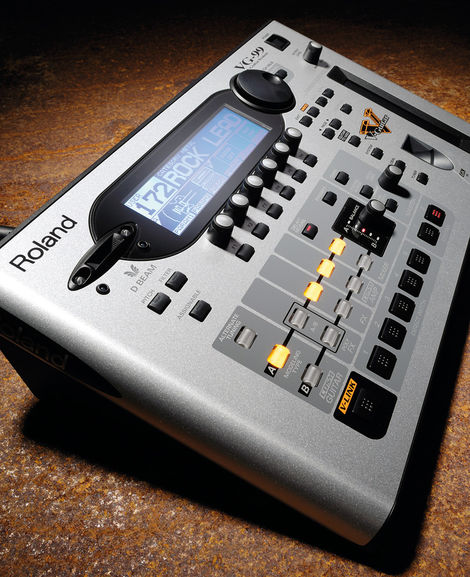 Roland VG99  TC Electronics G System  Fractal Audio Axe-FX Ultra Computer Audio chips can be roughly categorized like this: 1. integrated cards - these cards are of the worst quality. You get them with your motherboard and they should serve mainly as a worst case scenario backup situations. If you consider the fact that you get them for free bundled with the motherboard, you can presume what quality they have. Nevertheless newer motherboard models have more advanced chips and these cards are now enough for mainstream users, and some pilot recording projects. This is the looks of one chip called Realtek that is often used for integrated solutions: 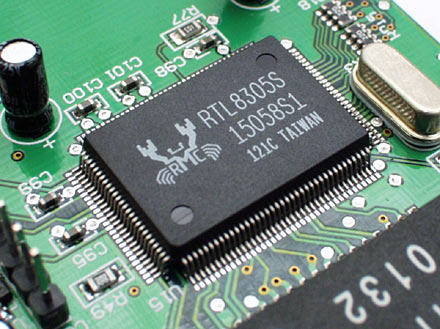 2. mainstream pc (aka gamer) cards - these cards are more expensive than integrated ones, they offer better sound quality, more clearer sound, and more accurate sound response. They also have bigger processing power than integrated ones, and the memory of their own, which enables them to add some effects on the sound of the computer. A lot of consumer cards will have options for enabling reverberation or chorus effects that can enhance gaming experience. The example of these cards are Creative Sound Blaster Series as one of the best selling cards on the market. Here's example of the high-end consumer market gamer card:  3. music production cards - these cards are mainly intended for music producing purposes, and branch into several categories, but most popular for beginners are audio interfaces. These interfaces have all the inputs and outputs for connecting instrument to computer and recording it with no problems. Interfaces are made mainly as external products, which means they serve as a external sound card with USB or Firewire connection. Here's an example of a cheap Line 6 interface, notice the guitar input and modeling software that you get with the device:  There are also other music production systems, both PCI, external or combined solutions, but let's not go in-depth about it now. If you wanna record sound on your computer, the wisest thing to do is to buy a small cheap guitar interface, like this Line 6 Toneport GX is on the last picture. This will get you a solid working sound card for recording, and program that has different guitar effects that you can apply to your guitar when recording in real-time. Couple of words about latency: In real-time speaking in audio production terms, means that there is a small amount of latency involved. In the end I wanna say that you can record things with your integrated card as well, just don't expect that good performance and you will need a device that will transfer your guitar unbalanced signal to line-level one that sound card can take via Line In. If you buy a cheap interface you will not have these problems and can record much better, and plug your guitar straight into interface. The latency will be small and you will have effects to color the sound a bit. In the following posts I will go through software and other interesting things you should know about making music at home! This post has been edited by Ivan Milenkovic: Aug 18 2011, 06:36 PM -------------------- - Ivan's Video Chat Lesson Notes HERE
- Check out my GMC Profile and Lessons - (Please subscribe to my) YouTube Official Channel - Let's be connected through ! Facebook! :) |
|
|
||
|
|
|
|
| Jun 5 2011, 10:12 PM |
|
Very nice! Excellent post Ivan!
-------------------- Visit my:
INSTRUCTOR PROFILE "If a composer could say what he had to say in words he would not bother trying to say it in music." Gustav Mahler Subscribe to my Youtube Channel here |
|
|
||
|
|
|
|
| Jun 5 2011, 10:23 PM |
|
Awesome article here. I'm sure this will help beginners a lot
This post has been edited by quadrium: Jun 5 2011, 10:24 PM -------------------- 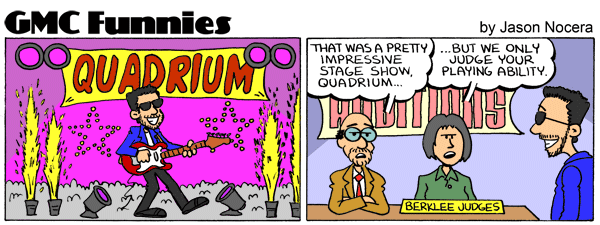 -------------------------------------------------------------------------------------------------------------------------------------------------- SPOTIFY PAGE YOUTUBE CHANNEL |
|
|
||
|
|
|
|
| Jun 17 2011, 09:11 AM |
|
Let's talk a bit about the connections today!
We all need to connect our gear in various ways, and there are always more than one piece of gear that we can connect, wetter it's only PC and amplifier line out. Many people connect these devices, and get noise problems, or even fried cards, and are not sure why. It turns out not all the connectors work on the same "level", as I will explain soon. LEVELS (VOLTAGES): As far as analog signals go, there are several different standards that had to be made, relative to the strength of the output signal from the source. Today, we use 3 of these standards: Line-level, Mic-level and Instrument-level. Line Level: One that is most commonly in use is "Line Level". It's used to standardize the voltage/strength of the input/output signals, in order to make connecting of various audio gear possible. Most gear that has Line Level inputs are CD and DVD players, consumer electronics like MP3 players, or integrated/consumer PC audio cards. The standard for Line Level signal is around 750 milivolts. What this means is that all the outputs or inputs that are marked as "Line", are usually operating at this voltage. For example, with intergrated sound cards you can see the arrow sign, or "Line In" or "Line Out" sign. This means that you can connect this line level output to another device that is operating at line signal voltage at their connectors. Mixing consoles usually have various inputs available, because of their function, so they usually have labeled out line level inputs as well. On most mixers, the last 4 or 8 channels (ones without XLR connectors, are usually operating only at 750mV (line-level). There are two types of line level: consumer line level is at -10dBV professional line level is at +4dBu (or dBm) In order not to get you confused with dBV and dBu values, it is just important to understand what goes where. Here are some common connectors and what line level they operate at: RCA (phono) connectors are usually -10dBV. XLR connectors are usually +4dBu (Mic Level). TRS quarter inch jack plugs can be either -10dBV or +4dBu, depending on the use. Mic Level: Microphones are operating at much lower voltages then line level devices, around 1mV - 80mV. This signal is too weak and prone to external interference. This means that a preamp is being used for microphones in order to get the mic-level low voltage signal to line-level high voltage signal. Instrument Level: Instrument level is not a standardized voltage, but can vary depending on the instrument's output, and it's usually somewhere between mic and line level voltages. Here's a hi-res picture of a mixer that has mic-level and line-level inputs: 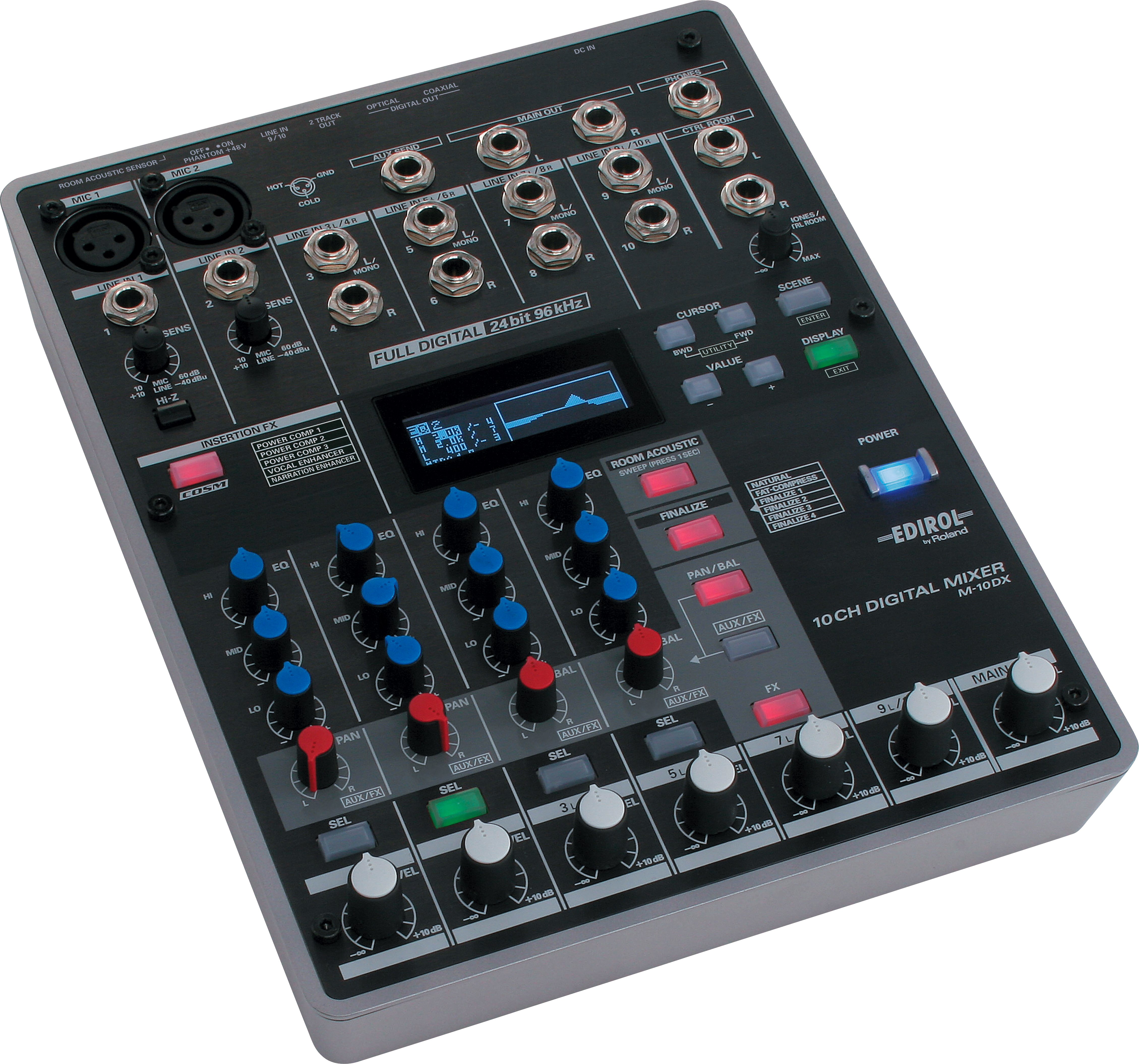 As you can see, XLR inputs are low voltage mic-level inputs, and they can handle lower voltage power, which means that you can "burn" the inputs by using the higher voltage sources like instruments or line-level devices. Preamps are very sensitive, and serve to amplify the low voltage mic signals to appropriate 750mV line-level. Also, notice that there are lots of line-level inputs available on the mixer. All these serve for standardized 750mV equipment. ______________________ In the next article I will write about impedance and balanced/unbalanced connections, which are closely connected to levels/voltages! -------------------- - Ivan's Video Chat Lesson Notes HERE
- Check out my GMC Profile and Lessons - (Please subscribe to my) YouTube Official Channel - Let's be connected through ! Facebook! :) |
|
|
||
|
|
|
|
| Jun 19 2011, 09:19 PM |
|
OK, let's continue with connections!
IMPENDANCE  A high impedance circuit tends to have high voltage and low current. A low impedance circuit tends to have relatively low voltage and high current. Impedance is usually labeled as "Z" and it is measured in "Ohms" (Ohm). If you connect a low-Z source to a high-Z load, there is no distortion or frequency-response change caused by this connection. But if you connect a high-Z source to a low-Z load, you might get distortion or altered response. When you connect an electric bass guitar or an electric guitar (a high-Z device) into an XLR-type mic input (a low-Z load). The low frequencies in the signal will roll off, so the guitar will sound thin. We want the guitar to be loaded by a high impedance, and we want the mic input to be fed by a low-impedance signal. A direct box or impedance-matching adapter does this. - Microphones and line outputs are usually low Z. - Electric guitars, synthesizers, and line inputs are usually high Z. - XLR mic inputs are low impedance; phone jack mic inputs are high impedance. BALANCED/UNBALANCED audio: Balanced audio is a method of interconnecting audio equipment using impedance-balanced lines. This type of connection is very important in sound recording and production because it allows for the use of long cables while reducing susceptibility to external noise. Balanced connections use three-conductor connectors, usually the XLR or TRS connector. XLR connectors, for instance, are usually used with microphones because of their durable construction, while TRS jack plugs are usually used for mixer inputs and outputs because of their smaller profile. TRS and XLR cables are basically the same, except having different connectors, you can see the picture for XLR male/female and TRS connectors: 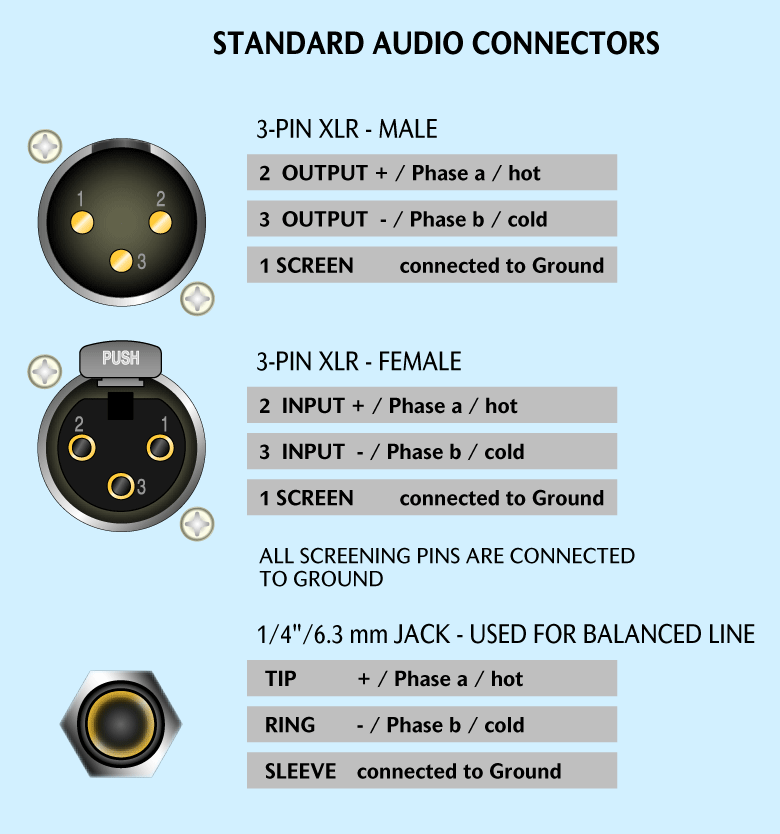 All these have ground wire, and two wires that carry the same signal, hot & cold. These two wires are phase-reversed, so they aren't susceptible to external noise. - Microphones usually have low-voltage, low impedance signal that is very susceptible to interference, and because of this, they are usually featuring balanced connectors. - Electric guitars and bass guitars have "mid" voltage, high impedance sources, and they usually have unbalanced connectors - Consumer audio devices usually feature unbalanced connectors - Prosumer audio usually feature both unbalanced and balanced connectors -------------------- - Ivan's Video Chat Lesson Notes HERE
- Check out my GMC Profile and Lessons - (Please subscribe to my) YouTube Official Channel - Let's be connected through ! Facebook! :) |
|
|
||
|
|
|
|
| Jun 19 2011, 11:13 PM |
|
this is excellent Ivan, thank you!
-------------------- Visit my:
INSTRUCTOR PROFILE "If a composer could say what he had to say in words he would not bother trying to say it in music." Gustav Mahler Subscribe to my Youtube Channel here |
|
|
||
|
|
|
|
| Jun 21 2011, 10:21 PM |
|
Cheers mate, more to come very soon!
-------------------- - Ivan's Video Chat Lesson Notes HERE
- Check out my GMC Profile and Lessons - (Please subscribe to my) YouTube Official Channel - Let's be connected through ! Facebook! :) |
|
|
||
|
|
|
|
| Jun 21 2011, 10:24 PM |
|
Omg how did I miss this thread! This is tasty wiki material, I'll make sure to put it all there Ivan
-------------------- Guitars:
Fender American Deluxe Stratocaster, Ibanez RG2570MZ, Epiphone SG G-400 Amp: Vox AC4TVH head + V112TV cab Effects: Vox Satchurator, Vox Time Machine, Dunlop CryBaby, Boss MT-2, Boss CE-5, Boss TU-2, Boss ME-70 Recording: Line-6 POD X3 + FBV-Express, Pandora PX5D GMC wants YOU to take part in our Guitar-Wikipedia! Have a good time reading great articles and writing your own with us in our GUITAR WIKI! Share your playing and get Pro-advice from our Instructors: Join REC |
|
|
||
|
|
|
|
| Jun 25 2011, 06:33 PM |
|
Thanks a lot mate. I'll do some modifications possibly as time goes by, and refresh the material weekly!
-------------------- - Ivan's Video Chat Lesson Notes HERE
- Check out my GMC Profile and Lessons - (Please subscribe to my) YouTube Official Channel - Let's be connected through ! Facebook! :) |
|
|
||
|
|
|
|
| Jun 26 2011, 12:35 PM |
|
After all this technical mumbo jumbo about connections, it's time to actually start pluggin in (finally)
1. Plug the guitar into an amp, mic the cab, and record the microphone sound into mic preamp/sound card 2. Plugging the guitar into guitar head with line out, or guitar preamp, and connecting to line in on sound card 3. Plugging guitar into processor, connecting the processor via analog or digital link to sound card 4. Connecting the guitar into audio card with Hi-Z input (aka audio interface) and modeling the tone from software 1. Plug the guitar into an amp, mic the cab, and record the microphone sound into mic preamp/sound card: The first option is the most expensive one, and it will require most money and biggest chunks of gear. The end result may prove to be most natural one, but only if you know what you are doing. Just as having a pro skate doesn't make you Tony Hawk (it actually guarantees lots of injuries! There is one (and only IMHO! Bad sides of this approach is that you have to play relatively loud (not important if you have deaf neighbours), you have to experiment a lot in studio, have nerves to always adjust, record, adjust record.. One important downside of this approach is that people usually have couple of amps only, and this will prove limiting after a while in creating various tones. If you do have the amp that you really like and it has your signature tone, there is always an option of getting another cool mic, another cool preamp, another cool stand, another cool acoustic foam, another cool cab... you see where this is going? various ways of micing this marshall cab  I will not put too much words about the factors that are important, but will mention some of the important ones, and leave you to experiment, cause this is the best way to actually observe and learn your particular gear in your particular recording situation: - proper room acoustics - quality balance of the complete gear chain (eliminating bottlenecks first) - choosing the best possible gear for the job - microphone placement and microphone combinations - loudness of the amp vs microphone sensitivity - setting the tone right in relation to musical arrangement/function - avoiding clipping and EQing (a lot) before recording - recording dry (unless there is nice acoustics available for capturing) In general, problematics of this kind of recording involves lots of factors, but with lots of experimenting and studying, great results can be achieved. I do recommend testing this method if you have the gear and means available. Since the gear list is big, and budget can increase greatly with each component, I do recommend thinking it over before you actually go into the shop and get everything you need. You might want to consider other options too. This method is as close as it gets to professional studio recording, so it might be worth taking a shot, and interesting experience for those who would like to taste some of that work. Like I said, the end results can be very satisfying after a while, and you will be richer for one cool experience, which will eventually help you in the emulating world too. Here applies the general rule: Once you learn how the "real thing" sounds, it will be easier to emulate it later through software. to be continued.... This post has been edited by Ivan Milenkovic: Jul 27 2011, 04:50 PM -------------------- - Ivan's Video Chat Lesson Notes HERE
- Check out my GMC Profile and Lessons - (Please subscribe to my) YouTube Official Channel - Let's be connected through ! Facebook! :) |
|
|
||
|
|
|
|
| Jun 26 2011, 05:56 PM |
|
Great posts
|
|
|
||
|
|
|
|
| Jun 26 2011, 10:04 PM |
|
Are you sure that this topic should be only for beginners ?
|
|
|
||
|
|
|
|
| Jun 26 2011, 10:31 PM |
|
This is awesome Ivan! Thank you for sharing this
--------------------  -------------------------------------------------------------------------------------------------------------------------------------------------- SPOTIFY PAGE YOUTUBE CHANNEL |
|
|
||
|
|
|
|
| Jun 29 2011, 04:39 PM |
|
OK, I'm adding all this info into our wiki in different articles, here they are:
https://www.guitarmasterclass.net/wiki/inde...ssor_for_Guitar https://www.guitarmasterclass.net/wiki/inde...ter_Audio_Chips https://www.guitarmasterclass.net/wiki/inde...tar_Connections I put links to the pictures in some of them, because I ignore whether we own the copyright of them, specially the diagrams, etc. I'll keep adding more -------------------- Guitars:
Fender American Deluxe Stratocaster, Ibanez RG2570MZ, Epiphone SG G-400 Amp: Vox AC4TVH head + V112TV cab Effects: Vox Satchurator, Vox Time Machine, Dunlop CryBaby, Boss MT-2, Boss CE-5, Boss TU-2, Boss ME-70 Recording: Line-6 POD X3 + FBV-Express, Pandora PX5D GMC wants YOU to take part in our Guitar-Wikipedia! Have a good time reading great articles and writing your own with us in our GUITAR WIKI! Share your playing and get Pro-advice from our Instructors: Join REC |
|
|
||
|
|
|
|
| Jul 27 2011, 05:07 PM |
|
Thanks a lot Fran!
I'm continuing the article of connecting guitar to various equipment, so this is the same article as the previous one, i'll notify when it's done! 2. Plugging the guitar into guitar head with line out, or guitar preamp, and connecting to line in on sound card This option was specially popular back in the days when there were little or no processors and software modellers available. Although it was used more before than now, it is still a great way to produce a healthy sounding guitar preamp tone, better than using software or processor for emulating the preamp. First what is guitar head with line out? If you've been reading the articles above, you will know that line out is most often used way of interconnecting audio equipment. Guitar heads/amps usually have speaker outputs which are definitely not something you would want to connect to any audio equipment but the speaker. The power would fry the components! Instead, by making a small signal detour, on various modern heads they make the signal come out as a low voltage output that can be recorded. This way you still get the sound of a head, but skip the poweramp and speaker components. On some heads you can find unbalanced, and on some heads even XLR balanced line output (like the Marshall JVM example bellow, check the hi-res picture)  Rear side view of a Marshall JVM head - notice the XLR line outputs If you have a guitar preamp on the other hand, like a stomp box preamp or a rack preamp, often there is line out on these devices. If you really like the sound of it, you can connect it to external recording gear as well, namely the sound card. It's outputs voltage and resistance are tuned in to line level standard.  Rear side view of a Marshall JMP-1 guitar preamp - notice the line outputs on the right side, and the consumer/pro switch for adjusting the line level output strenght As you can notice on most devices you can choose wetter it's consumer/pro switch, which means you can connect it to various gear, with various cables, XLR connectors/cables will usually "ask" for +4dBu, and mono jacks or RCA connectors will usually ask for -10dBV. XLR and TRS connectors are better (and usually present) since they are balanced, so you can introduce bigger length cables etc. Now, there is another issue about connecting guitar preamp directly to audio card. Sound sucks I won't go in-depth with speaker emulation options, I will leave it for another article, but will mention that there are usually three options that are being used for speaker emulation with this type of connection: 1. integrated speaker emulation (like the one you can see on the JMP-1 picture - far to the right, there are stereo outputs with speaker simulator) 2. separate speaker emulation circuit (used on older units where speaker emulation is not available, it is usually in the form of rack unit (e.g Palmer is one of the known manufacturers), or in the form of a floor D.I. box unit with speaker emulation circuit). 3. software emulation (direct sound of guitar preamp is being fed into audio card, and the sound is being processed with various speaker emulation software or plugin) to be continued.. This post has been edited by Ivan Milenkovic: Jul 28 2011, 10:40 AM -------------------- - Ivan's Video Chat Lesson Notes HERE
- Check out my GMC Profile and Lessons - (Please subscribe to my) YouTube Official Channel - Let's be connected through ! Facebook! :) |
|
|
||
|
|
|
|
| Aug 18 2011, 06:32 PM |
|
3. Plugging guitar into processor, connecting the processor via analog or digital link to sound card
This would be a good option for anybody that has a good processor, and wants to use it for digital recording. By "guitar processor" I mean external hardware device specifically designed to process guitar sound. Usually processors will be digital, which means they will have converters, but sometimes you will want to use analog processing too. Nothing wrong with that as well. Couple of important factors to consider here: Digital hardware processing: Because the processing is all happening in the guitar processor itself, computer CPU is relieved, and can work on something else. Cutting down on the converters: As I mentioned, in some rare cases, you might want to use an analog delay unit or something similar, so you process the signal in analog domain. But this happens rarely, as most devices today are digital. What this means is that these devices convert your analog guitar signal into digital one, process it, and then convert it back to analog signal, before passing on through line out. IF you want to connect to sound card (which also converts your signal into digital, and works with digital), this means you went through one D/A and one A/D conversion without needing to! It would be better if you could "give" the digital signal straight to the sound card, so you skip converters. How can you do that? Well, via digital link: There are 2 types of digital links widely used, one is S/PDIF and other ADAT Lightpipe. Both standards are widely used, although for processor usually S/PDIF is being used, with RCA connectors, because of their rugged construction.  Rear view of a Fractal Audio AxeFX - notice the S/PDIF RCA connectors under the "digital I/O" section So if you connect via digital link, you will skip D/A converter in your processor, and you will skip A/D converter in your sound card, which will improve your sound. If you happen to have S/PDIF on your gear (and it's a big chance that you do), use ANY RCA cable that you have to make the connection and clear out your signal a bit. No reamping: The downside of this approach is that when the processed signal comes into the sound card, you record it processed, and there is little possibilities for reamping later on. Suppose you want to make a different preset later? You will have to play it once again. This would be one downside of working with processed sound. This post has been edited by Ivan Milenkovic: Aug 18 2011, 06:33 PM -------------------- - Ivan's Video Chat Lesson Notes HERE
- Check out my GMC Profile and Lessons - (Please subscribe to my) YouTube Official Channel - Let's be connected through ! Facebook! :) |
|
|
||
|
|
|
|
| Sep 1 2011, 03:44 PM |
|
4. Connecting the guitar into audio card with Hi-Z input (aka audio interface) and modeling the tone from software
"Hi-Z" Input stands for high-impedance input. Instrument signal has high impedance compared to regular line inputs, and only these inputs should be used for plugging instruments like electric guitar and bass guitar. There can be a frequency rolloff if you use inputs that cannot load the high impedance, or in some cases you can even fry the input with a big signal peak. You can of course use any analog pedals that you have with Hi-Z input, like overdrive and such, if you want to introduce some analog outboard processing into the digital domain. I personally don't like this approach, because you should stay as clean as you can.  Combo inputs on audio interface (notice the Hi-Z switch) Recording clean: big thing with this approach is that it is relatively cheap and very flexible if you record clean guitars. Clean guitars are reusable in the process called reamping. Reamping means that you can process the raw clean signal infinite number of times over and over. Computers became fast enough for real time processing, so you can tweak the sound during playback, without applying any offline processing. A/D conversion: Working in digital domain always introduces conversion problems. Fortunately, audio interfaces and audio cards got advanced, so for the fraction of a cost of a dedicated guitar processor with similar converters, you can now get mastering grade converters, and spend the rest of the money on software. The better converters, better will be your signal in the digital domain. Using high sample rate and bitrate will preserve precious range and dynamics of the signal. Nothing better than healthy clean signal. Making a healthy signal: I will talk in more detail about this later on, but for software modelers to work properly, you need to make the signal healthy, which means use all the available headroom. In digital domain, clipping is happening above 0dB point, and contrary to analog domain, this clipping should be avoided at all times. Going near 0dB in peaks is perfect in order to get a nice healthy signal. Choosing software: When people choose software modeler, they instantly think of Guitar Rig. But there are so many plugins that can process guitar tone, and with many you can get nice effect. Instead of explaining each individually (I tried many, but not all), I'll just put down the list, and let you do the research: In alphabetical order by company ---------------- Acme Bar Gig - DIG (guitar amp) - BIG (bass amp) - Shred Suite (guitar amp) - Preampus series (guitar preamp) - several other guitar related plugins http://www.acmebargig.com FREE / VST / WIN Airwindows - Amps (guitar preamps, free) - CabSVT (bass guitar plugin) - Several other plugins http://www.airwindows.com/ Commercial, FREE / AU / OSX Antti Huovilainen - Saro (guitar amp) http://antti.smartelectronix.com/ FREE / VST / WIN Aradaz Amps - Green, White, Crunch (guitar amp) - Our Cabinet Simulator (cabinet modeller) http://aradaz.blogspot.com FREE / VST / WIN Audiffex - ampLion (guitar amp) - ampLion Free (guitar amp, FREE) - inTone Guitar (guitar amp) - inTone Bass (bass amp) http://www.audiffex.com Commercial, FREE / VST, AU / WIN, OSX Audioease - Altiverb (impulse loader) - Cabinet (cabinet simulator) - Speakerphone (impulse responses) http://www.audioease.com/ Commercial / VST, AU, RTAS, MAS / WIN, OSX Audio Damage - FuzzPlus (guitar stompbox, free) - Kombinat (distortion preamp) http://www.audiodamage.com/downloads...php?pid=ADF001 FREE, Commercial / VST, AU Auraplug - Ampfire (guitar amp) - California Sun (guitar amp, free) - Freetortion (stompbox plugins, free) http://www.auraplug.com/ FREE, Commercial / VST / WIN Bomb-Factory - Sansamp PSA-1 (guitar preamp) http://www.digidesign.com/index.cfm?...32&itemid=1074 FREE / RTAS, TDM / WIN, OSX BTE Audio - Juicy77 (guitar amp, free) - TS' Secret (tubescreamer emulator, free) http://www.bteaudio.com/products/index.html FREE, Commercial / VST / WIN d16 - Redoptor (guitar amp) http://d16.pl/ Commercial / VST, AU / WIN, OSX db audioware - Flying Haggis (guitar amp) http://www.db-audioware.com/flyinghaggis.htm Commercial / VST, AU / WIN, OSX Digidesign - Eleven, Eleven LE (guitar amp) - Sansamp PSA-1 (sansamp emulator) http://www.digidesign.com/eleven Commercial / RTAS, TDM / WIN, OSX Florida Music Co - Brackenbury-1 Tube Amp (guitar amp) http://www.hitsquad.com/smm/programs/Brackenbury/ FREE / VST / WOM Focusrite - Guitar FX Suite (guitar amp and effects) http://www.focusrite.com/products/so...itar_fx_suite/ Commercial / VST, AU / WIN, OSX Fretted Synth Audio - FreeAmp3, FreeAmp2 (guitar amp) - Helian (bass amp) http://frettedsynth.home.att.net/ http://rekkerd.org/fretted-synth/ FREE / VST / WIN Habib - KeFir (impulse loader) - Extremist (guitar preamp) http://habib.webhost.pl/ FREE / VST / WIN Heeb - CrunchDude (guitar amp) http://www.heebcomponents.net/CrunchDude/ FREE / VST / WIN Heptode - Heavy Tone, Deep Crunch (distortion pedal emulations) http://www.heptode.com/vst_plugins.html FREE / VST / WIN Ignite Amps - NRR1 (guitar preamp) - TS-999 (tube screamer pedal emulation) http://www.igniteamps.com/ FREE / VST, AU / WIN, OSX IK Multimedia - Amplitube series (guitar amp, several models) - Ampeg SVX (bass amp) http://www.ikmultimedia.com Commercial / VST, AU, RTAS, Standalone / WIN, OSX Image Line - Hardcore (stomp box sims) http://www.image-line.com/documents/hardcore.html Commercial / VST, AU, FL iZotope - Thrash (guitar amp) http://www.izotope.com/products/audio/trash/ Commercial / VST, AU, RTAS, TDM, DX / WIN, OSX Kazrog - Recabinet Modern, Recabinet Vintage (cabinet impulses) http://recabi.net/ Commercial Knufinke - SIR2 (impulse loader) - SIR1 (impulse loader, free) http://www.knufinke.de/sir/ Commercial, FREE / VST, AU / WIN, OSX Kuassa - Amplifikation Lite (guitar amp, free) - Amplifikation One (guitar amp) http://www.kuassa.com Commercial, FREE / VST, AU / WIN, OSX LePou - Solo C, HyBrit, LE456, Lextac, Legion, Lecto (guitar preamp) - Lecab (impulse loader) http://lepouplugins.blogspot.com FREE / VST, AU / WIN, MAC Line6 - Pod Farm, Amp Farm, GearBox (guitar amp) http://line6.com/podfarm/ http://line6.com/ampfarm/ Commercial / VST, AU, RTAS, TDM Markbass - Mark Studio 1 (bass amp) http://www.markbass.it/products.php?...&am...t=5&vedi=93 Commercial / VST, AU, RTAS, Standalone / WIN, OSX Mason Software - Dammit Distortion (guitar amp) http://masonsoft.hitback.se/ Commercial / VST, AU / WIN, OSX Massey Plugins - THC (distortion stompbox) http://www.masseyplugins.com/?page=thc Commercial / AU, RTAS, TDM / WIN, OSX Matthias Becker - Cortex (guitar amp) http://ncryptoworkz.blogspot.com/200...uitar-amp.html FREE / VST / WIN McDSP - Chrome Tone (guitar amp) http://www.mcdsp.com/index.php?optio...=44&Itemid=271 Commercial / RTAS, TDM / WIN, OSX Mellowmuse - Mellowhead (guitar amp) http://www.mellowmuse.com/Mellowhead.html Commercial / VST, AU, RTAS / WIN, OSX MDA - Combo (guitar amp) - several other free plugins http://mda.smartelectronix.com/ FREE (open source!) / VST, AU / WIN, OSX Mokafix - NoAmp (sansamp emulation, free) - a lot of stompbox emulations http://www.mokafix.com/ FREE / VST / WIN Native Instruments - Guitar Rig (guitar amp) http://www.native-instruments.com/#/...tar-rig-4-pro/ Commercial / VST, AU, RTAS, Standalone / WIN, OSX Ndzeit - Dirthead, TubeBaby (guitar amp) http://www.ndzeit.org/guitar/dirthead.html FREE / VST / WIN Nick Crow - Wagner Sharp, 7170, 8505 (guitar preamp) - Simple Guitar Combo (guitar amp) http://sites.google.com/site/nickcrowlab/ FREE / VST / WIN Nomad Factory - Rock Amp Legends (guitar amp) http://www.nomadfactory.com/products...amp/index.html Commercial / VST, AU, RTAS / WIN, OSX Overloud - TH1/TH2 (guitar amp) - Mark Studio 1 (bass amp) - Slego (guitar amp, free) http://www.overloud.com/ Commercial, FREE / VST, AU, RTAS, Standalone / WIN, OSX Peavey - Revalver (guitar amp) http://www.peavey.com/products/revalver/ Commercial / VST, AU / WIN, OSX Plektron - IRCab (cabinet loader) - Guitar Amp, Powered (guitar amp) http://www.plektronfx.com/products.php Commercial, FREE / VST / WIN Rob Rokken Audio - Roktion 808 Distortion Unit (distortion) http://robrokkenaudio.com/plugins/ FREE / VST / WIN Ronald Passion - X-1000, SS500, M-900, FV-70, Crunch Passion, Revolutionz, ReChrome, ReGold (guitar preamp) - Bass preamp, Slap Passion, Revolutionz bass (bass preamp) - DI Cab (cabinet simulator) http://rekkerd.org/ronald-passion/ http://www.1ststudio.blogspot.com/ FREE / VST / WIN Run Beer Run - several free guitar related plugins http://runbeerrun.blogspot.com/ FREE / VST / WIN Seibel - Lisarock (guitar amp) http://www.wix.com/leandroseibel/lisarock FREE / VST, AU / WIN, OSX simpleVSTs - urrth, duuaal, spaank (guitar preamp) - praamp, muun (stompbox simulations) http://simplevsts.blogspot.com/ FREE / VST / WIN Simulanalog - Guitar Suite (guitar amp and stompboxes, free) - SLO X-88 (guitar amp) http://www.simulanalog.org/guitarsuite.htm FREE / VST / WIN slim slow sider - Compact Distortion (distortion stomp box) Also has good free sidechain plugins! http://www.geocities.jp/webmaster_of_sss/vst FREE / VST / WIN Steinberg - Warp (guitar amp) http://www.steinbergcanada.com/produ...ts/warpvst.htm Commercial / VST / WIN, OSX Softube - Vintage Amp Room, Metal Amp Room (guitar amp) - Bass Amp Room (bass amp) http://www.softube.com Commercial / VST, AU, RTAS, TDM / WIN, OSX Studio Devil - Amp Modeler Pro, Virtual Guitar Amp (guitar amp) - British Valve Custom (guitar amp, free) - Virtual Bass Amp (bass amp) http://www.studiodevil.com/products/ FREE, Commercial / VST, AU, RTAS / WIN, OSX The Lower Rhythm - A-110, A-150 (guitar amplifier, free) http://urthwurk.com/thelowerrhythm FREE, Commercial / VST / WIN TSE - X30, X50 (guitar preamp) - TS808 (stombox) http://www.theserinaexperiment.net/ FREE / VST / WIN Two Notes Audio Engineering - Torpedo PI-101 (guitar suite) - Torpedo PI-FREE (guitar amplifier, free) http://www.two-notes.com/en/Two-Note...o-PI-FREE.html FREE, Commercial / VST, AU, RTAS / WIN, OSX Vandal Amps - Vandal Guitar Amp (guitar amp) http://www.vandalamps.com/en/media/.71.html Commercial / VST, AU / WIN, OSX VOX - Jam Vox (guitar amp) http://www.voxamps.com/jamvox/ Commercial / VST / WIN Voxengo - Boogex (guitar amp, impulse loader) http://www.voxengo.com/product/boogex/ FREE / VST / WIN Waves - GTR3 (guitar amp) - GTR Solo ("free for one year" guitar amp) http://www.wavesgtr.com/ Commercial / VST, AU, RTAS, TDM / WIN, OSX Wurr Audio - GreenMachine Amp II (guitar amp) http://www.greenmachine.pwuq.net/Wur.....;/Download.html FREE / VST / WIN Heavy weight ampsims like: Guitar Rig 5, Amplitube 3, Peavey ReValver MKIII, Vintage Amp Room, and other are among my choices. Each is good for a specific purpose, and that purpose depends on your needs and preferences. Conclusion: This method is computer-dependable. Ampsims are calculating tremendous amounts of data, and require very fast processing power. It takes a good PC to run several ampsims in demanding projects. If you already have a good computer, you should try some ampsims. If you work in DAW software, plugins are the first natural thing for creating fast drafts of your songs. Software is just practical. In recent years, algorithms got very advanced so hi gain tones are becoming increasingly realistic. As far as using ampsims for professional purposes, it's not going to work, although there is some use for them if you want some rawness, extra layering, or unusual effects in your recordings. They don't cut through the mix well, so it's important to place them properly in the mix. An experienced sound tech is required, one that knows how the real gear works. Then he can try to match it in the digital domain too. -------------------- - Ivan's Video Chat Lesson Notes HERE
- Check out my GMC Profile and Lessons - (Please subscribe to my) YouTube Official Channel - Let's be connected through ! Facebook! :) |
|
|
||
|
|
|
|
| Sep 1 2011, 03:48 PM |
|
WoW at that Ivan!
Bookmarking this to update the ongoing wiki article -------------------- Guitars:
Fender American Deluxe Stratocaster, Ibanez RG2570MZ, Epiphone SG G-400 Amp: Vox AC4TVH head + V112TV cab Effects: Vox Satchurator, Vox Time Machine, Dunlop CryBaby, Boss MT-2, Boss CE-5, Boss TU-2, Boss ME-70 Recording: Line-6 POD X3 + FBV-Express, Pandora PX5D GMC wants YOU to take part in our Guitar-Wikipedia! Have a good time reading great articles and writing your own with us in our GUITAR WIKI! Share your playing and get Pro-advice from our Instructors: Join REC |
|
|
||
1 User(s) are reading this topic (1 Guests and 0 Anonymous Users)
0 Members:


























